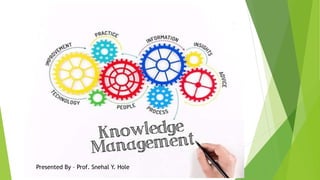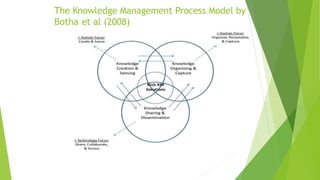This document summarizes and compares several knowledge management models:
- The KM Process Framework by Bukowitz and Williams (1999) outlines four stages - get, use, learn, contribute - and emphasizes the strategic focus and context of KM.
- The KM Matrix by Gamble and Blackwell (2001) splits the KM process into four stages: locating knowledge sources, organizing knowledge, socialization, and internalization. It provides guidelines for KM implementation but focuses only on knowledge sharing.
- The Knowledge Management Process Model by Botha et al (2008) presents KM as three overlapping categories - technology, people, and processes - and includes knowledge creation, but like the other models it lacks strategic context.





















